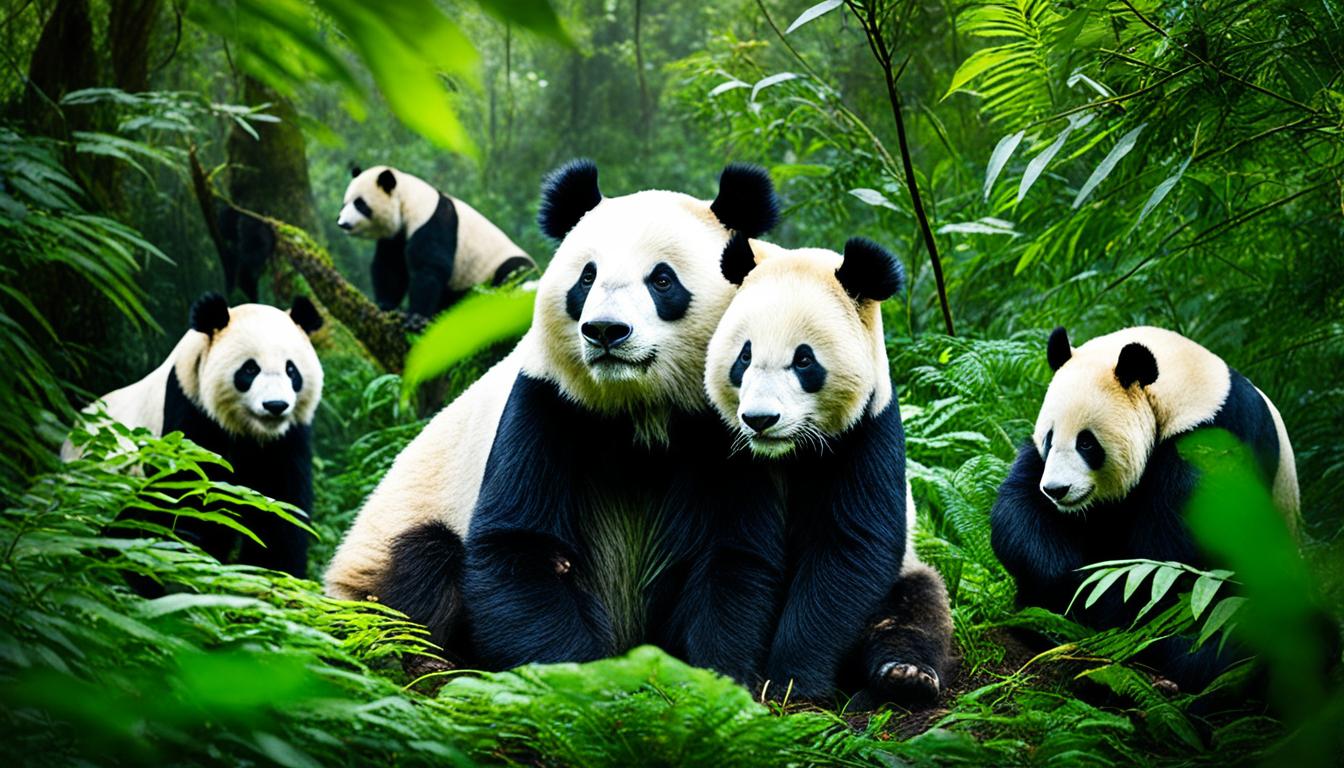Animals survive extreme weather through various strategies. They hibernate to conserve energy, lowering their metabolic rates and relying on fat reserves. Many migrate to find warmer conditions and food sources, steering using environmental cues. Physical adaptations, like thick fur or blubber, provide insulation against the cold. Some animals seek shelter to avoid harsh conditions. Others use camouflage to blend in with their surroundings, increasing their chances of survival. You'll discover even more fascinating strategies animals use to adapt.
Key Takeaways
- Animals enter hibernation to significantly reduce metabolic rates and rely on fat reserves during cold temperatures and food scarcity.
- Migration allows animals to escape harsh weather conditions and find more hospitable environments for survival and food availability.
- Physical adaptations, such as thick fur and blubber, help animals retain body heat and provide insulation against extreme cold.
- Camouflage enables animals to blend into snowy surroundings, enhancing their safety from predators and increasing foraging success.
- Seeking shelter in caves, dense vegetation, or burrows protects animals from severe weather while conserving energy.
Hibernation: Nature's Energy-Saving Strategy
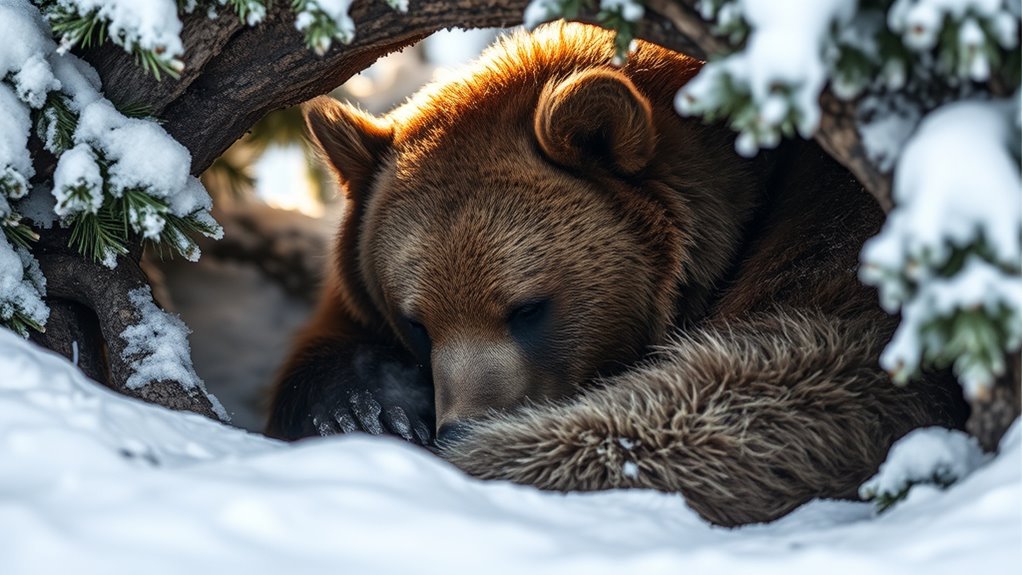
As temperatures plummet and food becomes scarce, many warm-blooded animals turn to hibernation, a remarkable energy-saving strategy. During this period, their metabolic rate, body temperature, and heart rate drop considerably, allowing them to conserve energy.
For example, black bears can lose 15%–30% of their body weight while relying on fat reserves to survive. Hibernation can last for months, with groundhogs entering this state as early as October.
This adaptation isn't exclusive to warm-blooded animals; some cold-blooded creatures, like wood frogs, also enter a hibernation-like state. By effectively lowering their physiological functions during harsh winters, these animals protect themselves from extreme conditions, ensuring they can emerge in spring ready to thrive when food becomes plentiful again.
Migration: The Great Journey for Survival
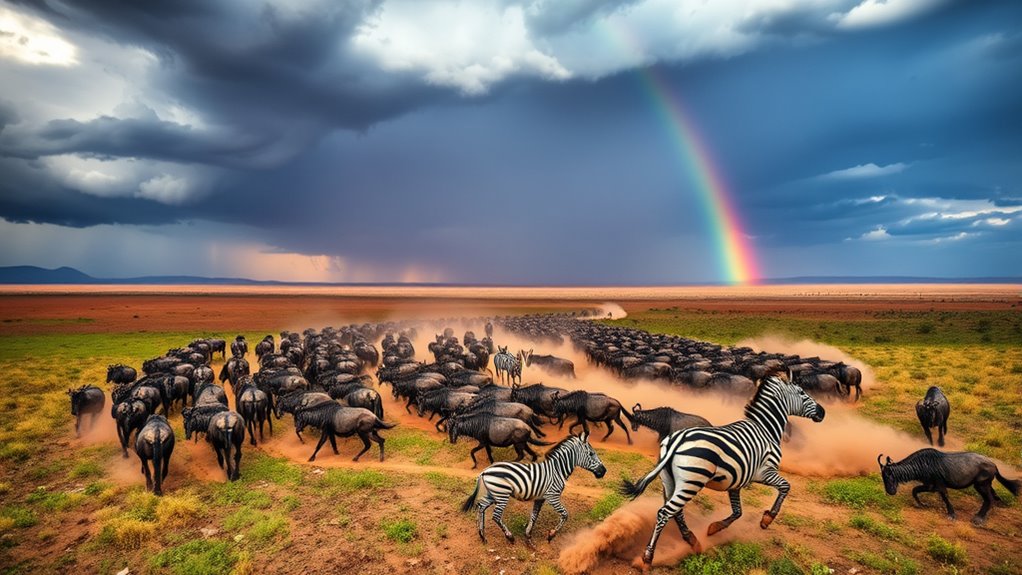
When temperatures drop and food becomes scarce, many animals initiate incredible migrations, traveling thousands of miles to find more hospitable environments.
This migration is often triggered by seasonal changes, pushing species like geese, caribou, and monarch butterflies to set out on long journeys. They navigate using instinct, memory, and environmental cues, ensuring they reach their destinations.
For instance, the Arctic tern covers around 44,000 miles annually, showcasing the lengths animals will go to survive the winter.
This remarkable phenomenon not only helps them escape harsh conditions but also maintains ecosystem balance by promoting food availability and nutrient cycling in different regions.
Ultimately, migration is a reflection of nature's resilience and adaptability in the face of extreme weather.
Adaptations: The Armor Against the Elements

After migrating to find more favorable living conditions, animals often rely on remarkable physical adaptations to endure extreme weather.
Thick fur coats, like those of Arctic foxes and polar bears, help retain body heat in freezing conditions. Marine mammals, such as seals and whales, possess blubber that can be up to two feet thick, providing essential insulation against icy waters.
Birds fluff their feathers to trap air, maintaining their body temperature during harsh winters. Cold-blooded animals, like wood frogs, have unique adaptations, including antifreeze proteins, preventing ice formation within their cells.
Additionally, specialized feet of arctic animals, such as snowshoe hares, allow them to navigate snow and ice, enhancing mobility and offering camouflage against predators.
Insulation Mechanisms: Keeping Warm in the Cold
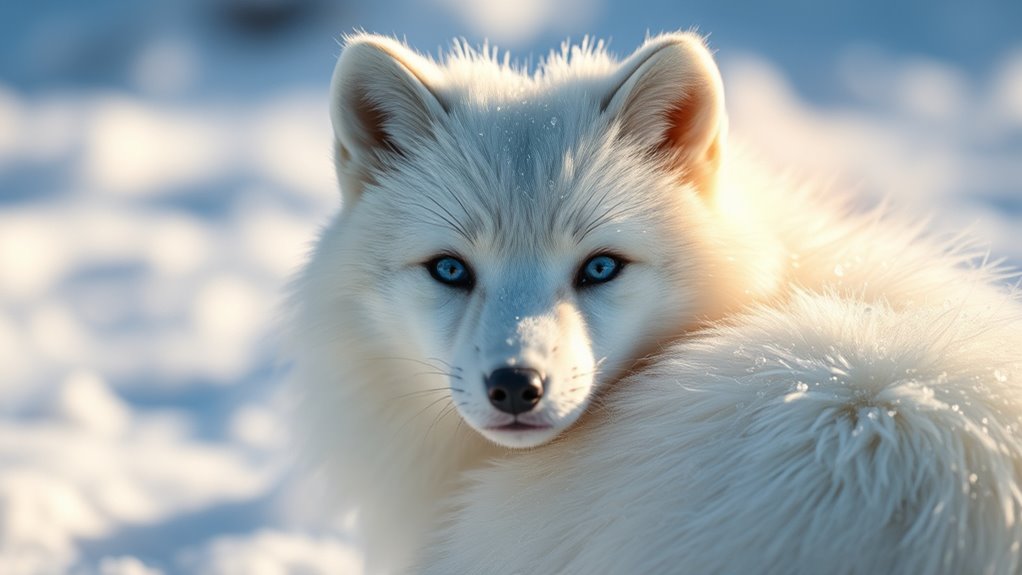
When you think about how animals stay warm in the cold, consider the impressive insulation mechanisms they use.
Thick fur coats and fat layers help warm-blooded creatures like bears and foxes maintain their body heat, while birds fluff their feathers to trap air and create a barrier against the chill.
Even marine mammals rely on blubber, which not only insulates but also provides energy during harsh conditions.
Fur and Feathers
As temperatures plummet, many warm-blooded animals, like arctic foxes and wolves, rely on their thick fur to trap air and provide essential insulation. This fur not only helps retain body heat but also enhances warmth by curling fibers that capture even more air.
In the avian world, birds fluff their feathers to create air pockets, boosting insulation and maintaining their body temperature in frigid conditions.
Polar bears take it a step further with specialized outer hairs that reflect heat back towards their skin, keeping them warm in icy environments.
Both birds and mammals engage in behaviors like grooming and preening to guarantee their fur and feathers remain effective at providing insulation against the cold.
Fat and Blubber
While many animals rely on fur and feathers for warmth, others depend on fat and blubber as their primary insulation mechanisms.
Marine mammals like whales and seals have a thick layer of blubber, sometimes up to two feet, that provides excellent insulation against cold water, helping them maintain body heat.
In land animals, fat layers serve a dual purpose: they insulate against the cold and act as energy reserves during harsh winters. For instance, chipmunks and squirrels rely on their fat stores to survive when food is scarce.
Additionally, sheep's wool and birds' feathers trap air, enhancing insulation.
These adaptations show how essential fat and blubber are for warmth and survival in extreme weather conditions.
The Role of Shelter: Finding Refuge From Harsh Weather

When harsh weather strikes, animals instinctively seek out shelter in their environment.
You might notice how some create nests in tree cavities while others burrow into the ground or find refuge in dense vegetation.
The location and type of shelter can be vital for their survival, providing warmth and protection from the elements.
Natural Shelters in Environment
Natural shelters play an essential role in helping animals survive extreme weather conditions, allowing them to find refuge from harsh elements. From caves to dense vegetation, these shelters create microhabitats with stable temperatures, vital for regulating body temperature. Birds use tree cavities to shield themselves from wind, while small mammals like rabbits dig burrows to escape both cold and predators. Reptiles and amphibians find refuge in mud, entering dormancy to conserve energy during freezing temperatures, and aquatic animals retreat to deeper waters to avoid icy surfaces.
| Animal Type | Natural Shelter |
|---|---|
| Birds | Tree cavities and shrubs |
| Small Mammals | Burrows |
| Reptiles | Mud or leaf litter |
| Amphibians | Dormant in mud |
| Aquatic Animals | Deeper waters |
Animal Nesting Behaviors
Animals rely on various nesting behaviors to create safe havens against harsh weather. Many species, like birds and small mammals, build nests or burrows for shelter, protecting themselves from extreme temperatures and predators.
For instance, sparrows and swallows use twigs, grass, and mud to craft intricate nests that provide insulation for their eggs and young. Similarly, rabbits and groundhogs dig burrows that serve as cozy retreats from freezing winds.
Arctic foxes, on the other hand, create dens in the snow, offering both insulation and safety in icy environments. You'll notice that animals often modify their nesting behaviors seasonally, reinforcing their nests with extra materials to enhance protection during the harsh winter months.
Importance of Shelter Location
Finding the right shelter location can mean the difference between life and death for many species during extreme weather.
Animals often seek natural protections like dense vegetation or caves to help regulate their body temperature.
Here's how they do it:
- Burrowing: Small mammals like rabbits dig burrows to escape predators and harsh climates.
- Snow Insulation: Arctic foxes use snow as a cozy microhabitat, staying warmer than the frigid air outside.
- Strategic Migration: Birds and caribou migrate to wintering grounds with ample food and shelter.
- Building Dams: Beavers create ponds with their dams, insulating them from freezing temperatures.
These shelter choices are vital for survival, especially when facing extreme weather challenges.
Physiological Changes: How Animals Adapt Internally
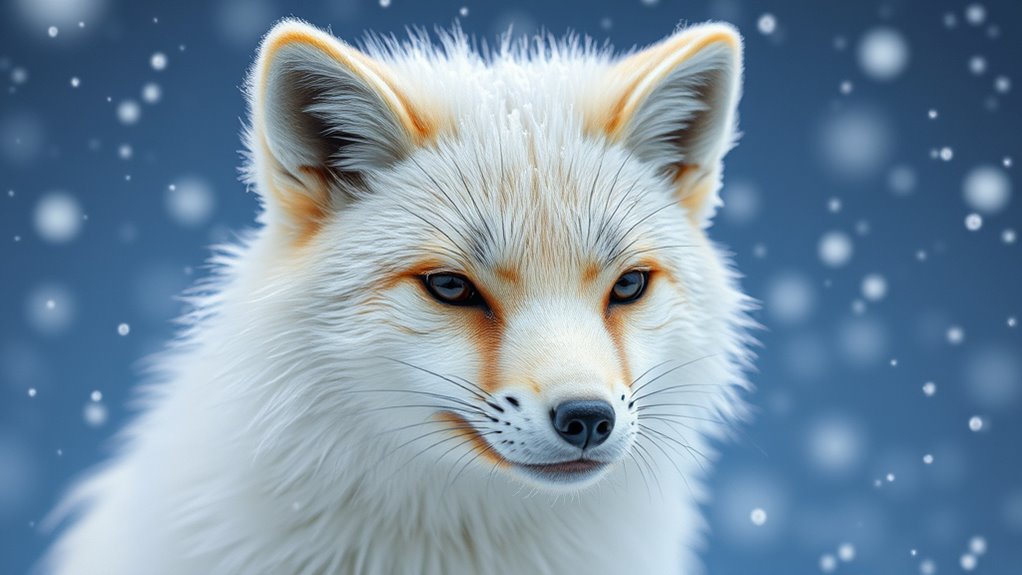
While harsh weather can be intimidating, many species have evolved remarkable physiological adaptations to thrive under extreme conditions.
To maintain their body temperature, animals often undergo physiological changes like increased fat storage and thicker fur coats, providing insulation and energy reserves during the cold. For example, warm-blooded animals such as bears considerably reduce their metabolic rate during hibernation, conserving energy while relying on fat reserves.
Animals adapt to cold through fat storage and thicker fur, conserving energy during harsh winter months.
Cold-blooded creatures, like wood frogs, produce antifreeze proteins that stop ice from forming within their cells. Birds have unique vascular systems that enable counter-current heat exchange in their feet, preventing freezing.
These adaptations help animals manage body heat and survive harsh environments, ensuring they can navigate extreme weather with resilience.
The Impact of Heavy Snow: Challenges for Wildlife

As heavy snow blankets the landscape, wildlife faces numerous challenges that can drastically affect their survival. During these harsh conditions, animals rely on adapted strategies to cope with the difficulties of winter.
Here are four key challenges they encounter:
- Movement Restrictions: Deep snow makes it tough for animals to find food and escape predators.
- Migration Needs: Species like elk and bison migrate to lower elevations where food is more accessible.
- Predator Vulnerability: Heavy snow increases prey mortality rates as escaping becomes harder.
- Adaptation Strategies: Smaller mammals often dig tunnels in the snow for insulation and protection during long periods of time when food is scarce.
These adaptations highlight the resilience of wildlife amid extreme weather.
Camouflage: Blending In and Staying Safe in Winter
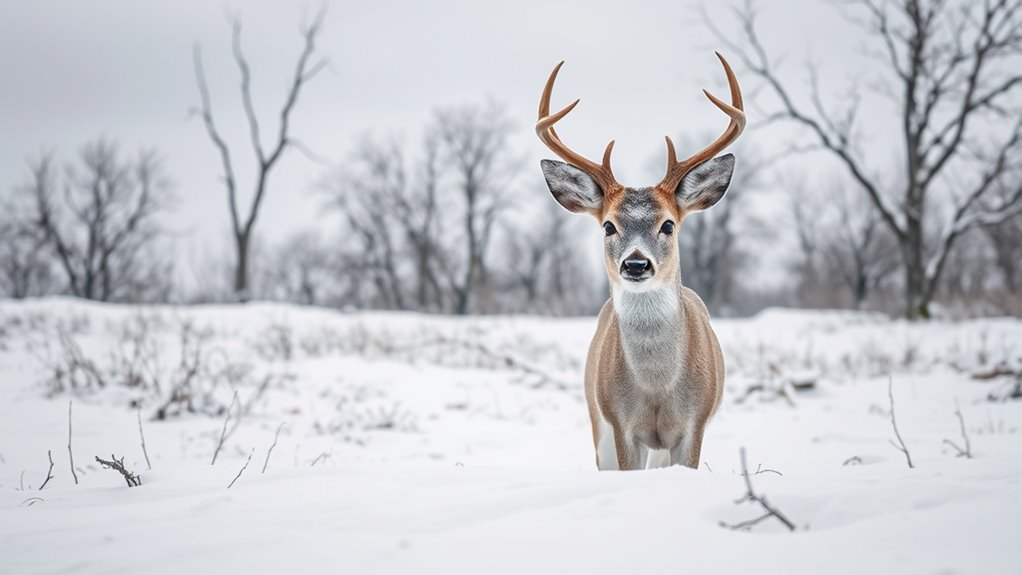
In winter, when snow blankets the landscape, many animals employ camouflage to blend in with their surroundings, enhancing their chances of survival. Snowshoe hares and ermine weasels, for instance, develop white coats that help them avoid detection by predators.
This ability to change color isn't just for looks; it plays an essential role in maintaining body temperature while providing effective camouflage against the snowy backdrop. Seasonal fur changes are critical for wild animals, influencing their hunting success during these harsh months.
While avoiding predators, creatures like the white-tailed deer can forage undetected, ensuring they find enough food to survive. Camouflage is an indication of the intricate survival strategies that wildlife employs in extreme winter conditions.
Frequently Asked Questions
How Do Animals Adapt to Survive in Extreme Environments?
Animals adapt to survive in extreme environments through various strategies.
You'll notice some develop thick fur or blubber for insulation, while others store fat for energy during harsh conditions.
Cold-blooded creatures may enter suspended animation, allowing them to survive freezing temperatures.
Additionally, specialized adaptations, like changing fur color for camouflage or unique vascular systems in birds, help them maintain body heat and avoid predators, enhancing their chances of survival in challenging habitats.
How Do Wildlife Survive Extreme Cold?
When the world turns into a frozen canvas, wildlife adapt like artists, using nature's brush to survive extreme cold.
You'll find bears hibernating, their bodies slowing down like a clock winding down, conserving energy until spring.
Other creatures, like wood frogs, enter a deep freeze, resilient as ice itself.
Elk and bison migrate, seeking warmth, while snowshoe hares don white coats, camouflaging against the winter's harshness, each finding their own way to endure.
What Do Animals Do in Severe Weather?
In severe weather, you'll notice animals taking various actions to stay safe. Some seek shelter in burrows or trees, while others migrate to lower elevations for better food access.
Birds fluff their feathers for insulation, helping them stay warm. You might even see certain creatures enter suspended animation or freeze, waiting for conditions to improve.
Many mammals also increase their food intake beforehand, building fat reserves for energy and insulation during harsh weather.
Which Animal Can Survive in Extreme Temperature?
Did you know the woolly bear caterpillar can survive temperatures as low as -90°F (-68°C)?
If you're curious about animals thriving in extreme temperatures, search no more. The Arctic fox uses its thick fur for insulation and camouflage, while camels can withstand scorching heat, going a week without water.
Each of these remarkable creatures has adapted uniquely, enabling them to endure environments that would be unbearable for most other animals.
Conclusion
In the grand tapestry of life, animals weave their survival strategies with remarkable ingenuity. Whether they hibernate, migrate, or adapt, each species showcases nature's resilience against extreme weather. Their unique methods, like a well-crafted shield, protect them from the harsh elements. As you ponder these incredible feats, remember that the dance of survival is ongoing, reminding us that life, in all its forms, is a demonstration of adaptability and strength in the face of adversity.



